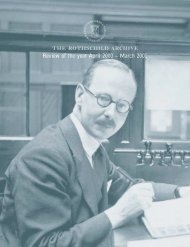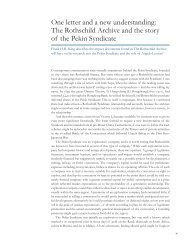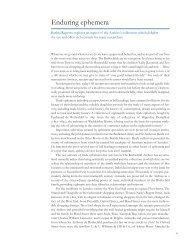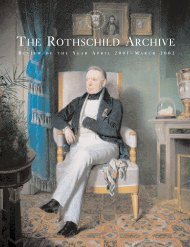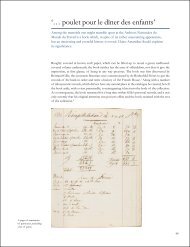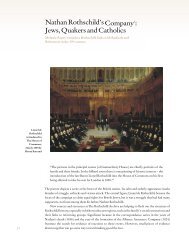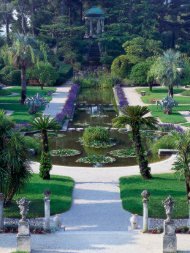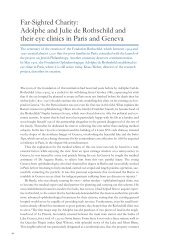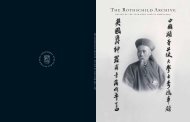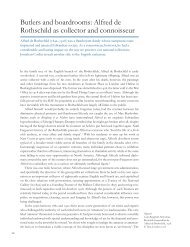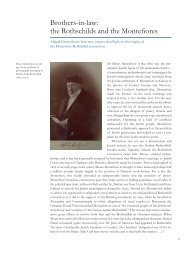66900 Rothschild Archive - The Rothschild Archive.
66900 Rothschild Archive - The Rothschild Archive.
66900 Rothschild Archive - The Rothschild Archive.
Create successful ePaper yourself
Turn your PDF publications into a flip-book with our unique Google optimized e-Paper software.
Butlers and boardrooms: Alfred de<br />
<strong>Rothschild</strong> as collector and connoisseur<br />
Alfred de <strong>Rothschild</strong> (1842–1918) was a flamboyant dandy whose sumptuous taste<br />
impressed and amused Edwardian society. As a connoisseur, however, he had a<br />
considerable and lasting impact on the way we perceive our national collections.<br />
Jonathan Conlin reveals another side to the foppish caricature.<br />
In the family tree of the English branch of the <strong>Rothschild</strong>s, Alfred de <strong>Rothschild</strong> is easily<br />
overlooked. A second son, a reluctant banker who left no legitimate offspring, Alfred was an<br />
active collector with a style of his own. In the years after his death, however, the paintings<br />
and other furnishings from his two residences at Seamore Place in London and Halton in<br />
Buckinghamshire were dispersed. <strong>The</strong> former was demolished in 1938, the latter sold to the War<br />
Office in 1918 after war-time use by the Royal Flying Corps as an officers’ mess. Although the<br />
massive conservatory and lavish gardens have gone, the central block of Halton has been carefully<br />
preserved by the RAF. Its popularity as a film location notwithstanding, security concerns<br />
have inevitably left this monument to <strong>Rothschild</strong> taste largely off-limits to the public.<br />
Alfred himself would probably be entirely forgotten today, had the contrast between his<br />
diminutive physical presence and flamboyant lifestyle not caught the eye of Max Beerbohm.<br />
Satires such as Roughing it at Halton have immortalised Alfred as an exquisite Edwardian<br />
hypochondriac, a Fabergé Humpty-Dumpty terrified that he might get broken after all, despite<br />
having all the King’s doctors and all his footmen on hold to put him back together again. Niall<br />
Ferguson’s history of the <strong>Rothschild</strong>s presents Alfred as someone who ‘lived the life of a fin de<br />
siècle aesthete, at once effete and faintly risqué’. ₁ With his tendency to turn up for work at<br />
New Court at 2pm (only to enjoy a long lunch and afternoon nap), Alfred’s aloofness seems<br />
typical of a broader trend visible across all branches of the family in the decades after 1870.<br />
Increasingly suspicious of co-operative ventures, many individual partners chose to withdraw<br />
capital rather than live off interest, immersing themselves in charitable activity while at the same<br />
time failing to seize new opportunities in North America. Although Alfred’s informal diplomacy<br />
around the turn of the century does not go unremarked, for the most part Ferguson casts<br />
Alfred in a subsidiary role, as a curious yet ultimately ineffectual figure.²<br />
<strong>The</strong>re was one field, however, where Alfred loomed large: government arts administration,<br />
and specifically the direction of the great public art collections. Here he built on his own reputation<br />
as an important collector of eighteenth-century English and French art, and capitalised<br />
on his close relations with government, securing appointment as a Trustee of the National<br />
Gallery (in 1892) and as a founding Trustee of the Wallace Collection (in 1897) and serving continuously<br />
in both capacities until his death in 1918. Although the powers of such Trustees are<br />
relatively limited today, in the period considered here they exerted considerable influence over<br />
policy on acquisitions, cleaning, access and hanging. In Alfred’s day, however, this power was<br />
being challenged.<br />
In the years between 1880 and 1920 there arose a new generation of art critics and experts<br />
who challenged the authority of such titled art lovers (or ‘amateurs’) to lead museums. <strong>The</strong> very<br />
label ‘amateur’ threatened to become pejorative. It had previously been used to denote a wealthy<br />
individual endowed with special understanding and knowledge of art by the financial and emotional<br />
stake in the artworks he owned. Yet those who sought to malign the amateur as amateurish<br />
had yet to formulate a viable concept of the discipline we now know as ‘art history’. <strong>The</strong><br />
Opposite<br />
Lady Bampfylde, Sir Joshua<br />
Reynolds, bequeathed by<br />
Alfred de <strong>Rothschild</strong>, 1918.<br />
© Tate, London 2006<br />
26



